LG G8X ThinQ Review
LG G8X ThinQ Review
A phone with a trick that’s equal parts a novelty and useful
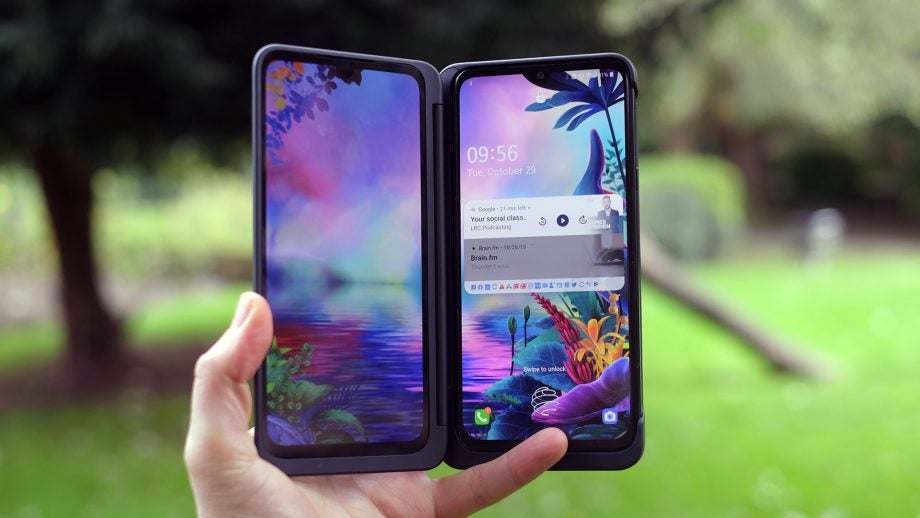
Verdict
If the dual screen accessory was something that drew you to the LG V50, then you should certainly consider this model instead. It fixes many of the issues of the first-gen unit and makes a much stronger case for the product to exist.
Pros
- Good main camera
- Decent battery life
- Has a headphone jack, a good one
Cons
- Dual screen accessory is clunky
- LG UX interface isn't the prettiest
- No zoom camera
Key Specifications
- Review Price: £TBC
- Android 9.0
- Snapdragon 855
- 128GB storage
- 6GB RAM
- 6.4-inch 2340 x 1080 OLED screen
LG has not tried to compete directly with the top phones from Samsung and Apple with its latest wave of phones. The result is the LG G8X ThinQ.
This is a top-end mobile with some of the same hardware as the £800-1000 models. But the price is low enough to offset LG’s relative lack of raw brand cred these days.
At this point LG has even intersected with the former darling of affordable phones. The LG ThinQ G8X costs $699 with the “second screen” case accessory, similar to the cost of the OnePlus 7 Pro.
But is the LG G8X ThinQ as good? No. The design is a little more conservative. The fingerprint scanner is not as reliable. The camera array is not as versatile and the speakers could be more powerful. However, it is a solid all-arounder well worth considering if your network offers a good deal for the handset.
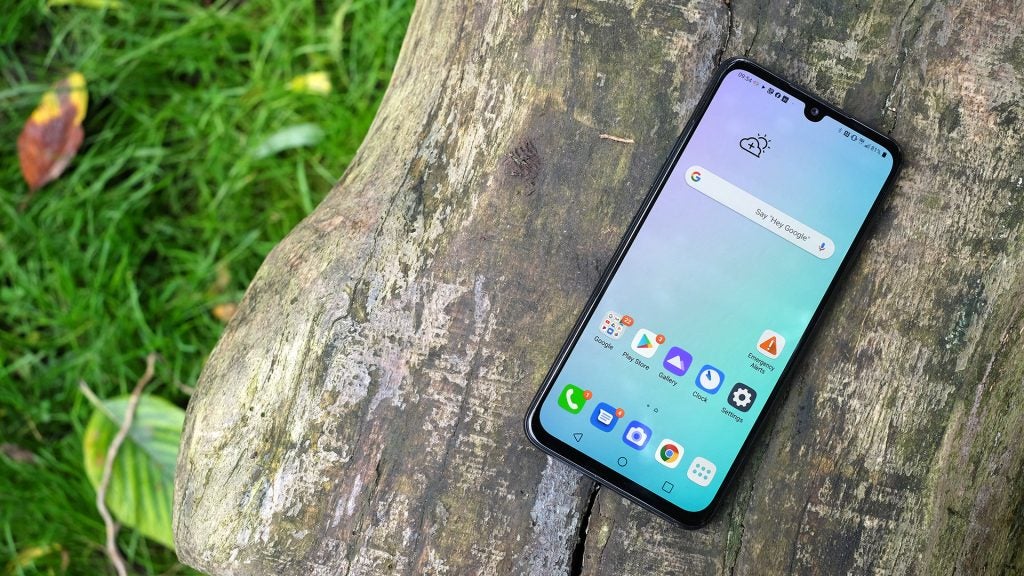
LG G8X ThinQ Design – Metal and Glass
The LG G8X ThinQ has a design to match its price – it’s not remotely cheap, but is more affordable than the Samsung Galaxy S10 Plus or iPhone 11 Pro. It is metal and glass, and has a large screen but not the tiniest screen surrounds around. Its notch style, a little dimple at top of the display, could these days belong to a £200 phone.
This is a good-looking, somewhat minimalist phone. But if you want one people will instantly recognise as ultra-pricey, the LG G8X probably isn’t it, not least because the phone is unlikely to be hugely popular, or an enthusiast’s choice like a OnePlus.
A few parts of the hardware do stand out. No part sticks out of the LG G8X ThinQ back. The rear Gorilla Glass 6 panel is used to cover both the cameras and the dual-LED flash. That silver border around the lenses? It sits behind the glass.

This puts a lot of faith in the scratch resistance of Gorilla Glass 6. Most phones still have raised metal borders around the camera housing to take the brunt of any scrapes. And Oppo’s recent Oppo Reno 2 has a little metal dot that lifts the back off the camera glass ever-so-slightly.
Some may say the LG G8X ThinQ style is a gamble, but it does look good. The back isn’t a completely flat panel of glass either. It curves at all four sides for a smooth look and feel.
LG also earns bonus points for its use of a headphone jack. Hardly any new £500-plus phones have one these days. LG has an extra reason to add one too. An advanced DAC has been a left-field draw of higher-end LG phones for several years, and the LG G8X ThinQ is no different. It has the same 32-bit DAC as the LG G7 ThinQ.
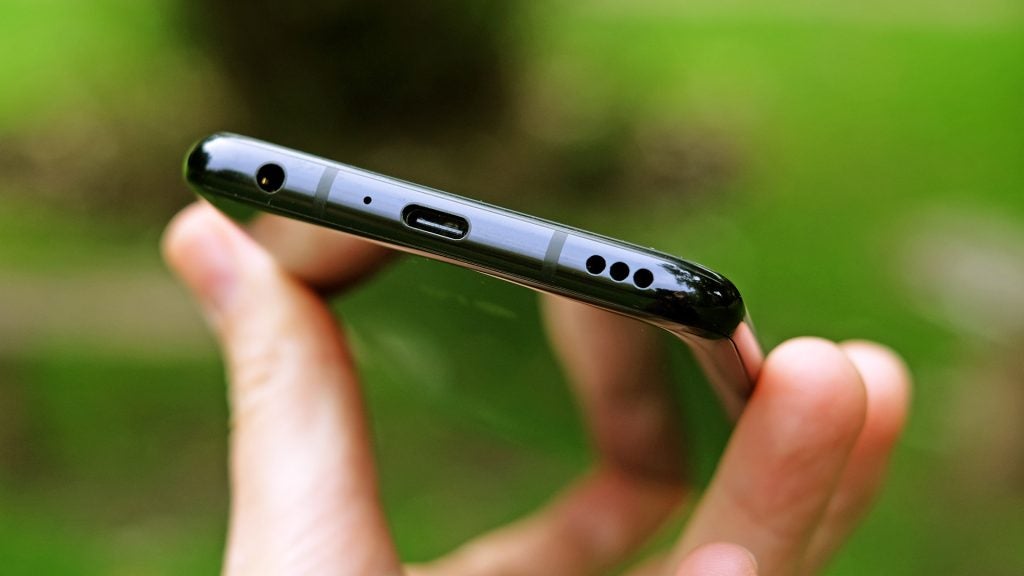
What does it do? This translates the digital audio data your phone’s apps produce into an analogue signal your headphones can relay. It does nothing for wireless headphones, as they receive audio digitally and there’s a DAC in the headphones themselves.
This is a good fit for higher-end wired headphones, as the amplifier inside is good too. The headphone jack alone is a solid draw for many at this point, though.
With such a focus on audio, I’m a little disappointed by the LG G8X ThinQ’s own speakers. There’s one on the front, another on the bottom, but the sound is not that loud or powerful. I switched to the G8X from the Google Pixel 4XL, and its speakers are significantly better. However, the sound gets a boost if you sit the phone on its back against a solid surface, as it resonates a bit.
The fingerprint scanner does not impress either. This is an in-screen scanner, placed in the usual thumb-friendly position towards the bottom of the screen. However, it is not particularly fast and seems to require far more second (or third) attempts than other phones I’ve used recently with similar scanners. I’ve tried re-teaching the LG G8X ThinQ my fingerprint, but it continues to fail to recognise my thumb regularly.
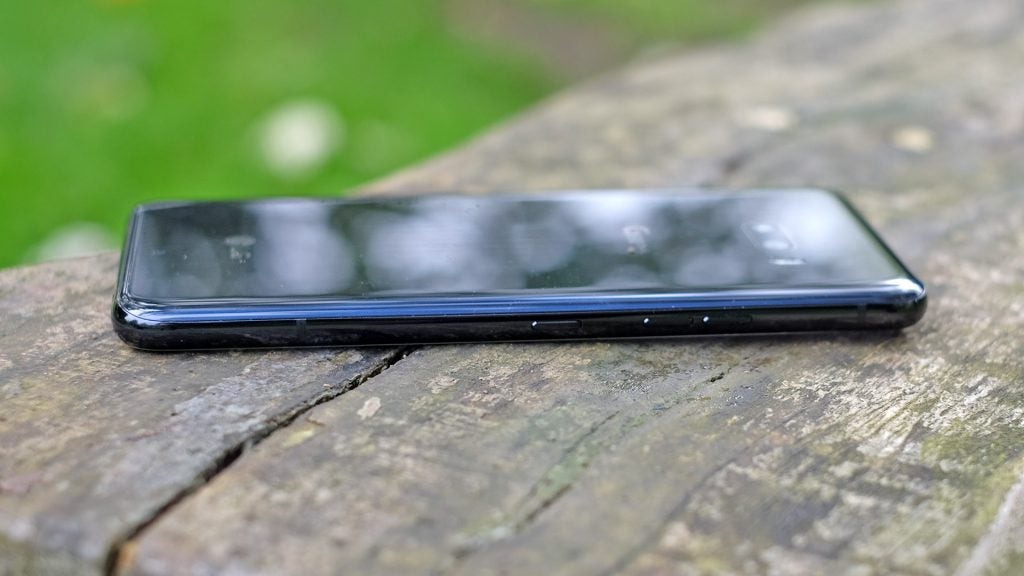
The other notable hardware extra was seen in the LG G7 too: a Google Assistant button on the left hand-side. And like last time, you can’t re-map it do anything else at launch. Still, it’s handy to have if you like Google Assistant, and does not get in the way if you don’t.
The LG G8X ThinQ is also water resistant to IP68, ready for complete submersion. My advice, as ever, is not to do this deliberately.
LG G8X ThinQ Screen – Is this a real foldable?
There’s a good chance you’re here because you have seen the LG G8X ThinQ described as a dual-screen phone. This makes it seem like a cheaper alternative to something like the Samsung Galaxy Fold.
The reality is a little different. You can get the LG G8X ThinQ with the LG dual screen case. This plugs into the phone itself using a USB-C connector, and has two screens of its own. There’s a small, low-res 2.1-inch OLED panel on the front, which shows you the time, battery life and recent notification icons.
This is similar to the display you might see on a windowed “folio” style case.
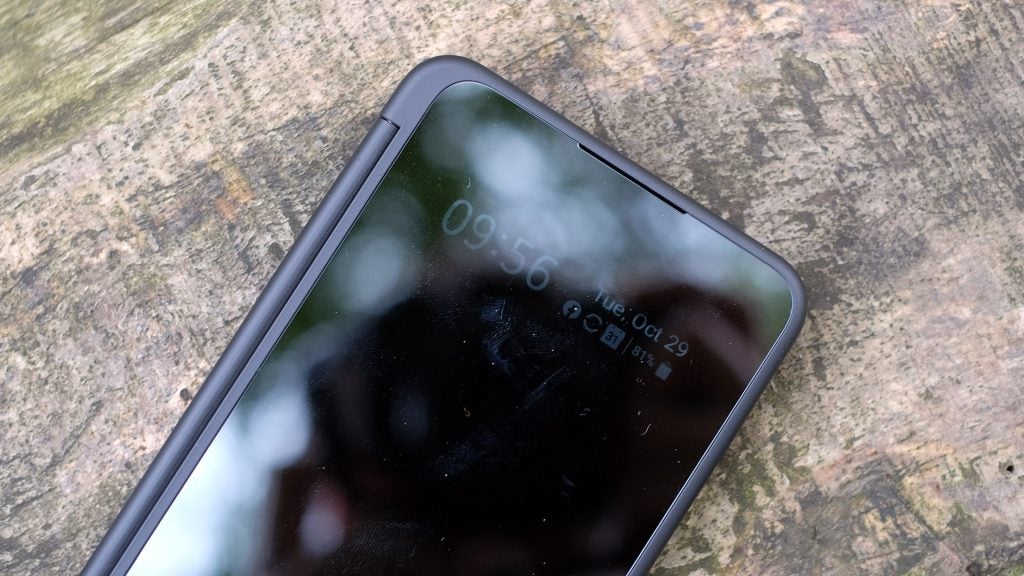
The display inside is more interesting, a 6.4-inch OLED screen that matches the main screen millimetre-for-millimetre. You use this as a second screen. It lets you run two apps at once, and you can load apps on either display. Fire up Chrome and you can also make a webpage scroll between the two.
Both are touchscreens, both have access to the app drawer and the second screen even gets its own homescreen, to which you can add a widget or two.
LG has made the software that gets this working, and it has done its best. You can, for example, make the LG G8X ThinQ’s second screen launch an app automatically when dual screen is used.
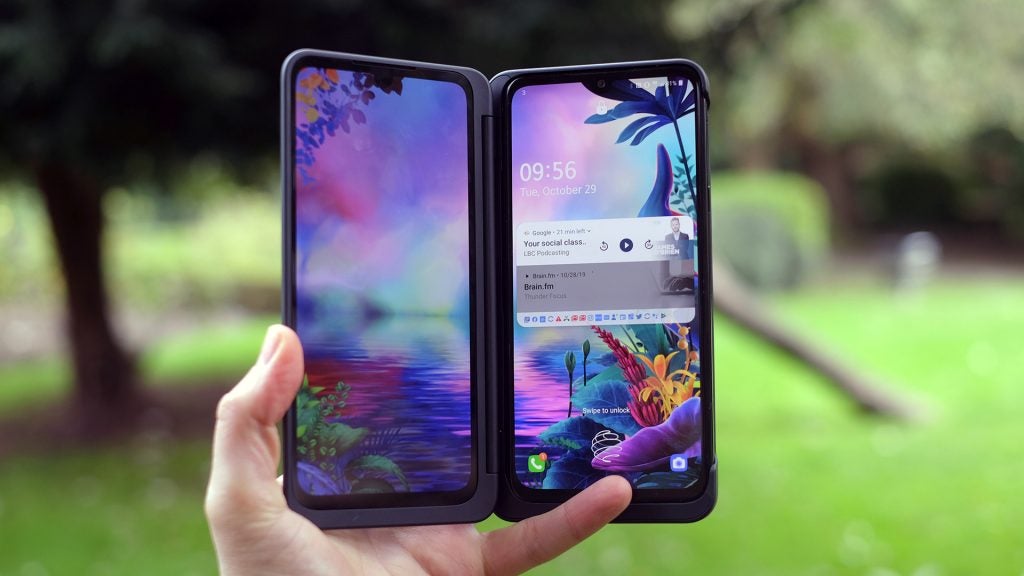
Gaming is the best use for the dual screen. You can turn one of the displays into a virtual controller, and there are four baked-in presets. They cover Xbox-style pads, retro controllers and a car steering wheel. How well they work depends on whether a game has been optimised for a gamepad.
Ark: Survival Evolved works well, PUBG less so. However you can also design your own layouts, and these are then linked the games you made them for. You lay down the buttons, then drag the corresponding touch zones they control on the other screen. This worked very well for Sonic 1, which barely needs any buttons and works best with a minimal layout. It had me playing all the way through the Green Hill zone.
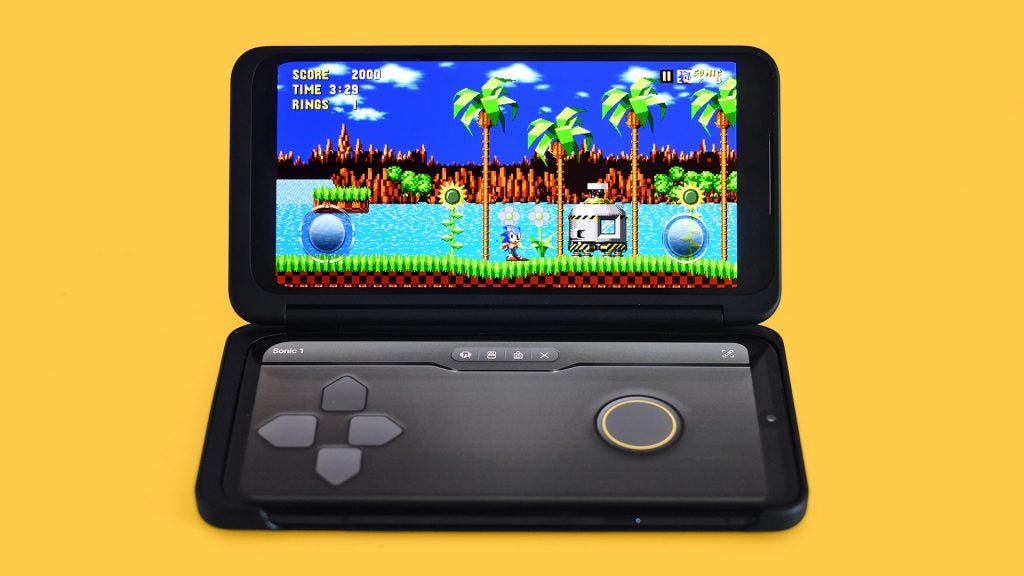
Yep, that horrible D-pad placement is (mostly) deliberate
The LG Gamepad feature lets you add little haptic feedback buzzes when you press a button too. Is it a replacement for a real physical controller? No, and buttons won’t respond if your other thumb is resting on a non-mapped zone. That caused a few lost lives in Sonic. However, it’s more practical than carrying around a Bluetooth controller, and frees up the screen so your thumbs don’t obscure the visuals.
There’s still a sense that the dual screen is a work-in-progress. I’ve encountered some strange bugs. Sometimes the soft keys go AWOL when you remove the case, although LG is likely to fix such problems fairly swiftly with software updates.
Size is the real issue here. The LG G8X ThinQ is huge with the dual screen case attached. It adds more than a centimetre of width to the phone.
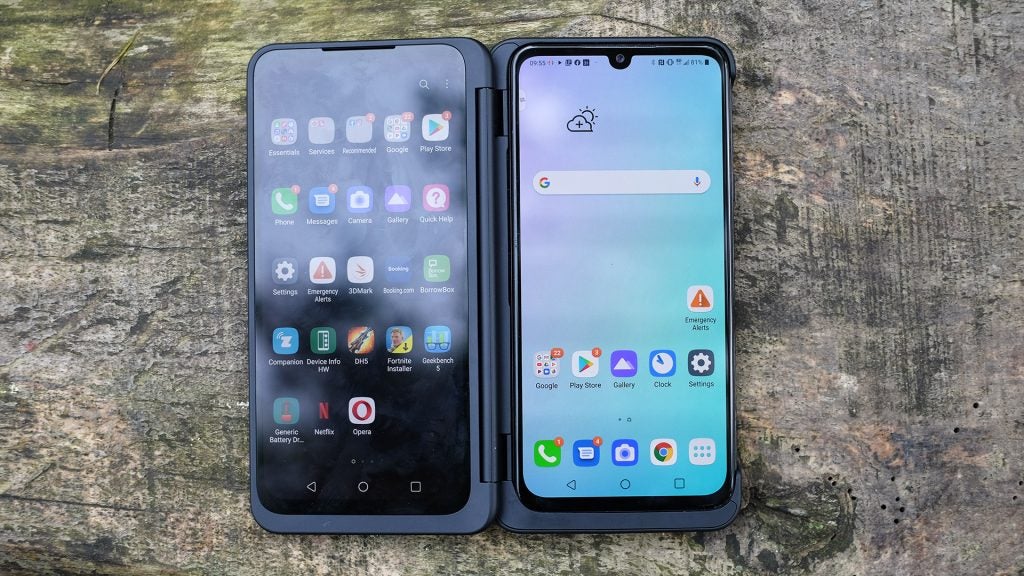
Still, the dual screen case feels more likely to hold up to real life better than a Samsung Galaxy Fold. Its front and inside panels are glass, and the outer is covered with rubberised plastic. The hinge feels solid too, although the way the tension varies a lot through its articulation makes it seem an experimental accessory. Apple wouldn’t release something like this for the iPhone.
Adding a pointless notch will seem odd to many too. There’s no camera in it, although it’s likely there so when apps are flung over from the main screen, the screen shape and style are identical.
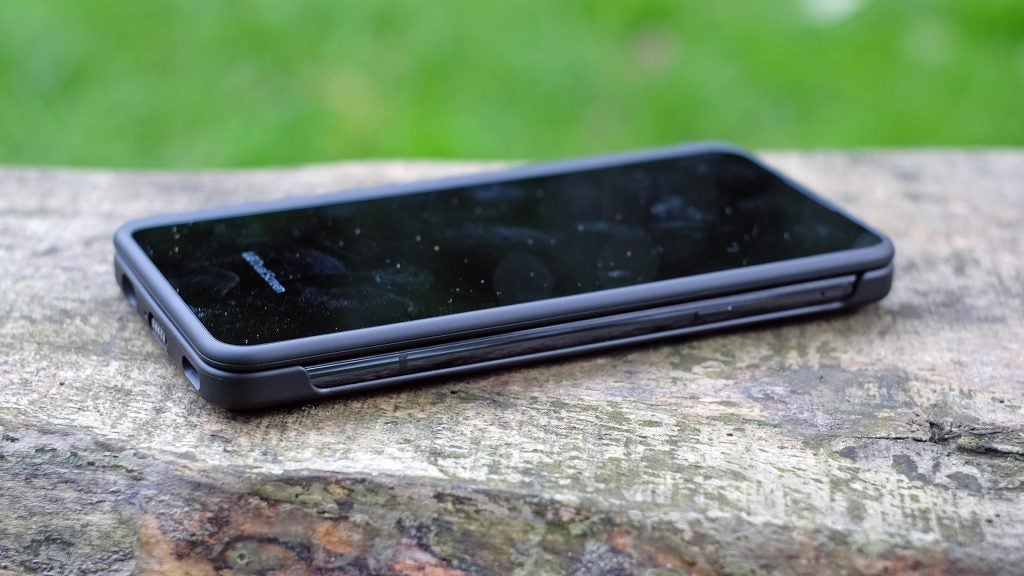
The second screen’s quality is very good for an add-on like this. It’s a 6.4-inch 2340 x 1080 pixel OLED, but in my LG G8X at least there’s a slight but noticeable difference in colour tone between the two panels.
I have mostly used the G8X without the second screen as it’s more practical flying solo. The main screen is also a 6.4-inch OLED panel of 2340 x 1080 pixel resolution, similar to the OnePlus 7T’s.
Top brightness is excellent and the effect of the just OK pixel density is only evident when you look at the LG G8X ThinQ close-up. The phone also has an always-on screen mode, handy for checking out the time when the phone is sat next to your laptop (yes, your laptop can tell you the time too).
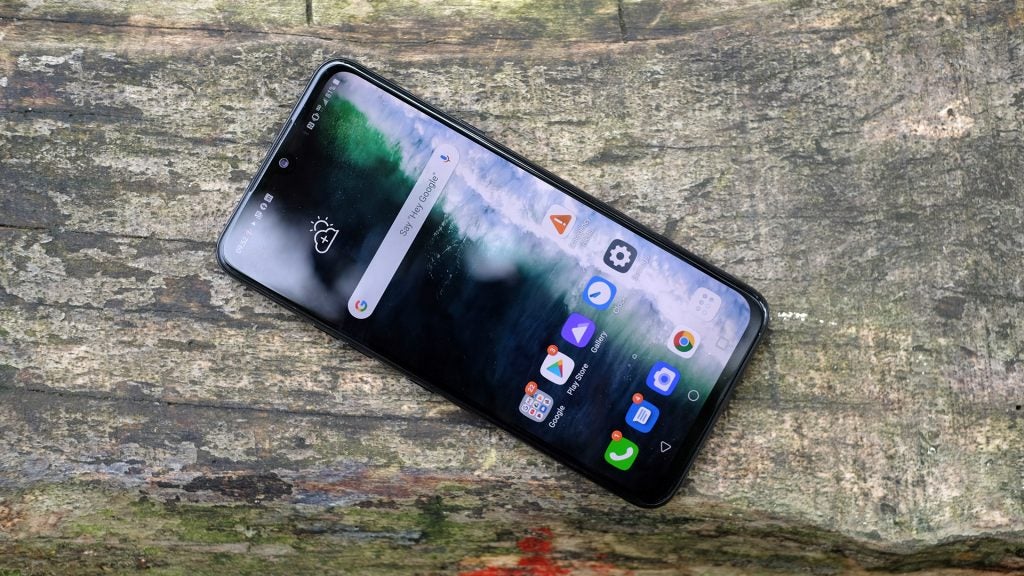
I’m not a huge fan of what LG has done with its screen calibration, though. The LG G8X ThinQ has a whopping seven display modes, mimicking Samsung’s old style (it has since slimmed down your options). However, where Samsung used these modes to make the screen line-up with industry standards, LG’s mostly seem to alter colour temperature. All preset modes bar “Web” are fairly saturated.
To get a relaxed sRGB appearance to you have to use the Expert mode, dig into the Advanced settings and pull down the saturation slider. You also need to play with the LG G8X ThinQ to get clean-looking whites.
Other manufactures handle OLED screens better. But this is still a high-quality OLED screen so we’re quibbling about the top 10% of performance here, and you have the controls to get the screen looking as you like. After fiddling my G8X ThinQ looks great to my eyes.
The OLED panel itself is not the most advanced around, though, as it has a standard refresh rate of 60Hz, not the 90Hz on offer in phones like the OnePlus 7T and Google Pixel 4XL. 90Hz is a “nice to have” extra, and it makes Android’s menus seem to glide by more smoothly, but there’s a real question of whether it’s worth the extra battery drain.
LG G8X ThinQ Software – LG’s skin isn’t the best
The LG G8X ThinQ runs Android 9 and has LG’s custom interface. It offers a few neat extras like the always-on screen mode mentioned earlier, which keeps the time in view, and the ability to dress up the notch area.
You can add a gradient effect to the top half-inch of the screen, keep it bare or black it out.
This kind of customisation seemed appealing back in the early days of notches when they seemed a bit odd and unsettling, but nowadays LG’s bonus gradients seem a little unnecessary, even tacky. Let your own eyes be the judge on this one.
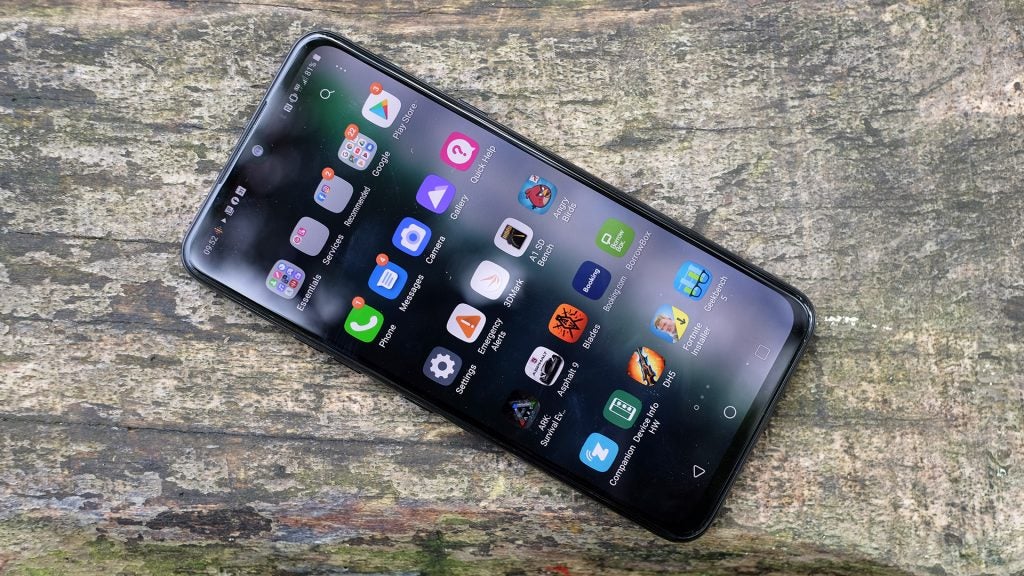
Other parts are raise the question of taste too. The LG interface squishes icons fonts to make text fit in place, and it ends up looking odd. You wouldn’t catch Apple doing this, as its reputation for design relies on tasteful consistency. Fiddling about with the width an aspect of characters is the opposite of this.
LG UX also diverts from “standard” Android in its app drawer style, like some other custom UIs. There’s no app drawer by default, and if you add one it’s arranged in pages rather than as one long scroll.
The G8X ThinQ’s UX interface is one of my least favourite custom Android UIs. It hasn’t developed all that much in the last few years, even though this is a “new” version, and some elements would raise a designer’s eyebrow. But would it stop me buying the phone? Absolutely not.
Android runs well, and if you really don’t like how it looks you can use a Launcher app. These paste over the top layer of an interface with their own. I’ve largely stopped caring about the little software quirks that annoyed me at first.
LG G8X ThinQ Performance – A strong performer
The LG G8X ThinQ has one of the best processors available to Android phones at present. It’s Qualcomm’s Snapdragon 855, a Kyro 485-based CPU with an Adreno 640 GPU.
Qualcomm has since released a Snapdragon 855+, to keep the progress train rolling on, but it is effectively an overlocked Snapdragon 855 and performance gains are not huge.
The LG G8X ThinQ’s dual screen add-on lets you test the processor’s power like no other phone. I tried loading up Ark: Survival Evolved and PUBG at the same time, expecting a lot of stuttering. The LG G8X ThinQ can play both games with their graphics maxed-out at the same time and the frame rates are still better than those of some mid-range phones playing just the one title. They are pretty smooth.
This tells you quite how little of the Snapdragon 855 Adreno 640 CPU’s power most Android games actually tap into. Do I want to play Ark and PUBG at the same time? No, but the power to do so is here.
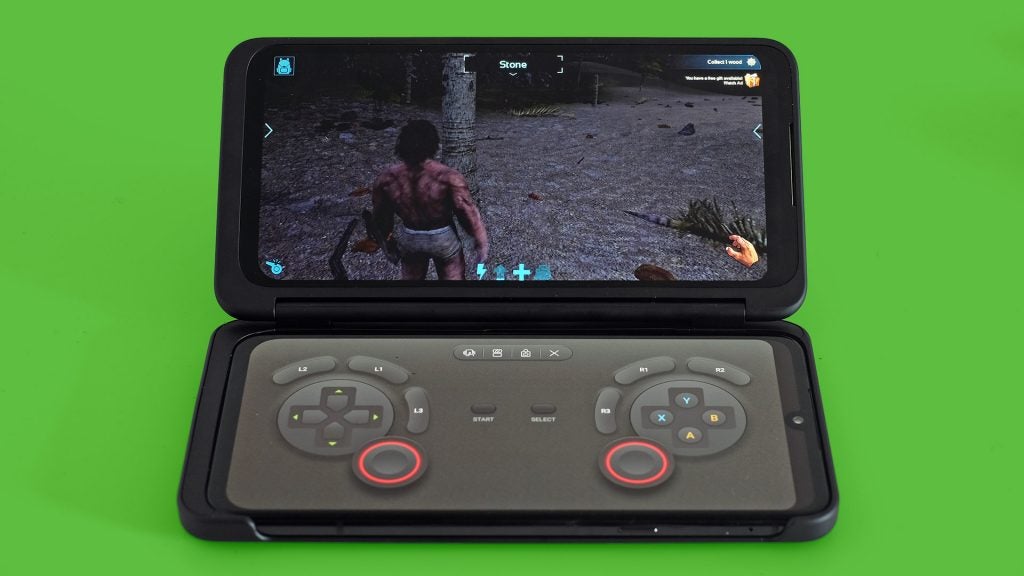
The phone also has 6GB RAM and 128GB storage. There’s nothing to complain about here, but at this point it’s hard to ignore Chinese rivals. The Xiaomi Mi 9T Pro costs around £240 less and has the same specs. The OnePlus 7T, perhaps a more familiar name in the UK and US, has the “Plus” version of the Snapdragon 855 and 8GB RAM. It is around £150 less.
You know how everyone has said for years that China was going to take over pretty soon? We’re seeing that start to happen in phones right now, and it’s hard not to be swayed. You used to have to import Xiaomi phones, but now they are readily available in the UK, complete with the extras we expect in the west, like Gmail – how bourgeois.
LG G8X ThinQ Cameras – We miss the zoom
The LG G8X ThinQ has two rear cameras, an ultra-wide and a standard one. There’s no zoom camera, and I do miss it.
You can pinch to use digital zoom, but even at 2x there’s the same major hit to image quality that has made photographers dismiss this “enlarge and crop” measure since forever. However, the hardware does represent a big upgrade over the LG G7.
Last year’s phone used a 16-megapixel sensor and had a bad habit of leaving big overexposed areas in your images at launch. The LG G8X ThinQ has the 12-megapixel Sony IMX363 sensor, the same used in the Pixel 4 XL.
This is the highlight of the camera line-up. The other two, the ultra-wide and selfie camera, use Samsung sensors (s5kdg1, s5k3m3), and they are rarely anything to get excited about.
The central hardware of the main camera is a match for the Pixel 4XL, but is the image quality? Not quite.
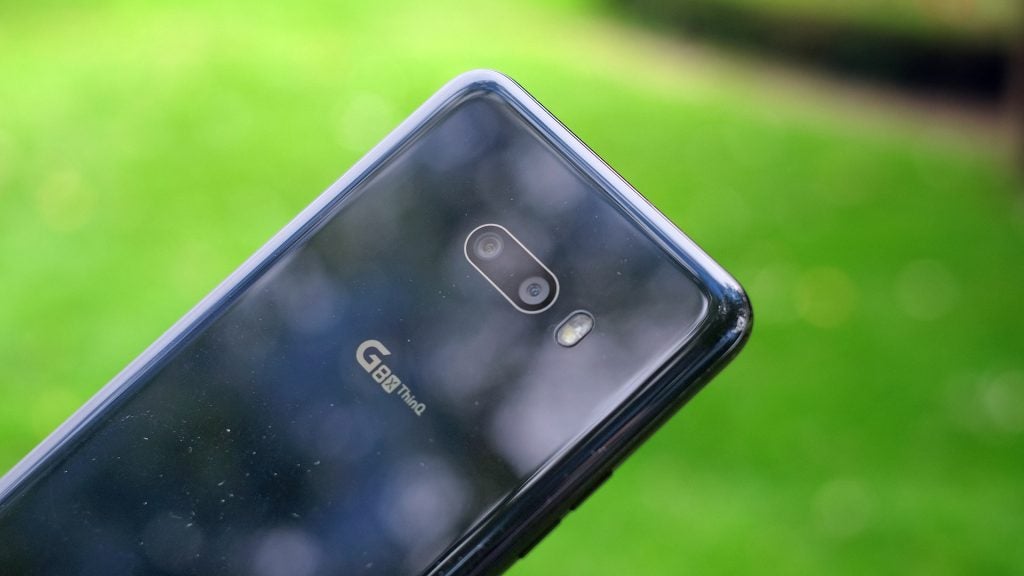
Its processing doesn’t handle fine textures as well and the Night View low light mode is a step below the best. However, you can take excellent photos with the phone. Its colour reproduction is tasteful, dynamic range optimisation is mostly excellent and detail seems great until you compare it directly with the very best phone cameras in the world.
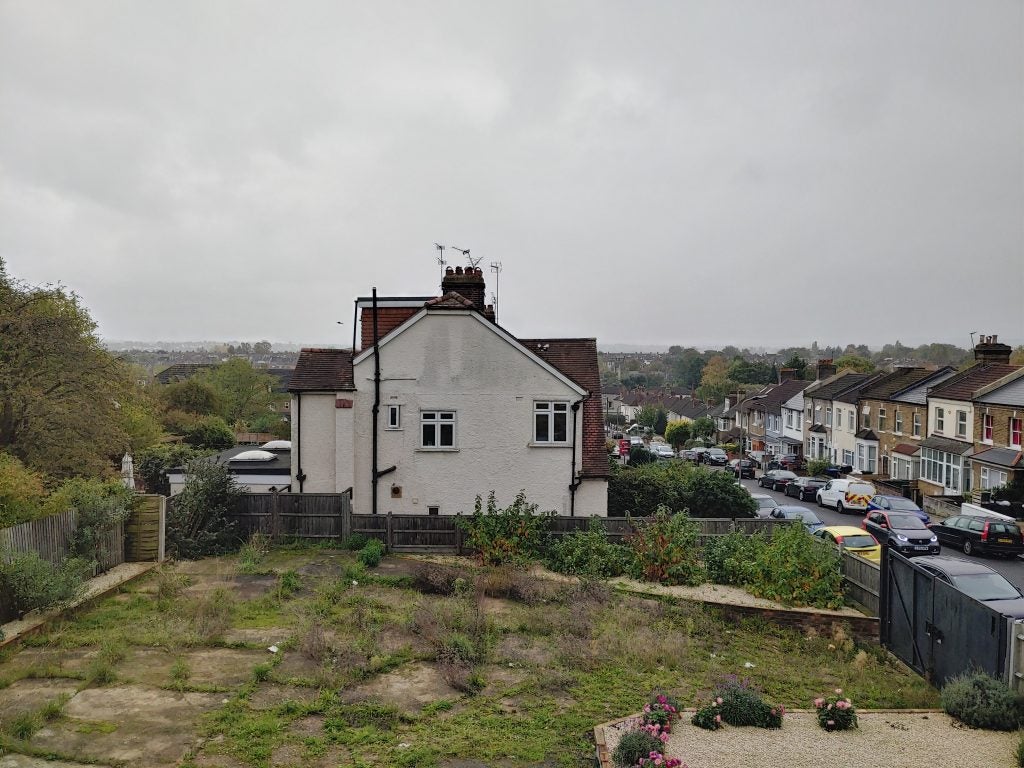
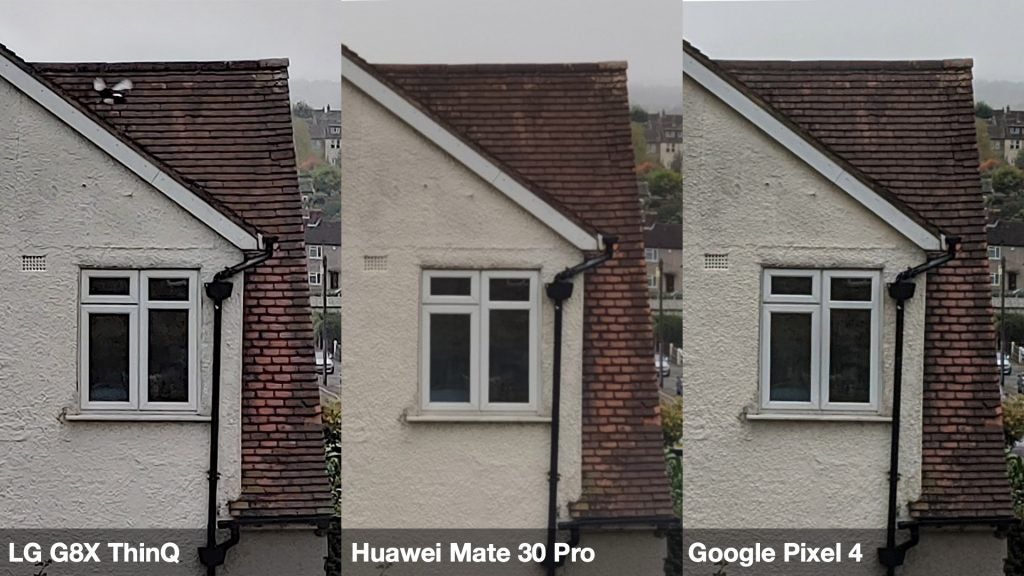
The LG initially looks very detailed, but the texture is more faithful in the other phones. Also, check out the missing vertical lines in some of the upper tiles. The LG is more sharpened and has slightly less detail.
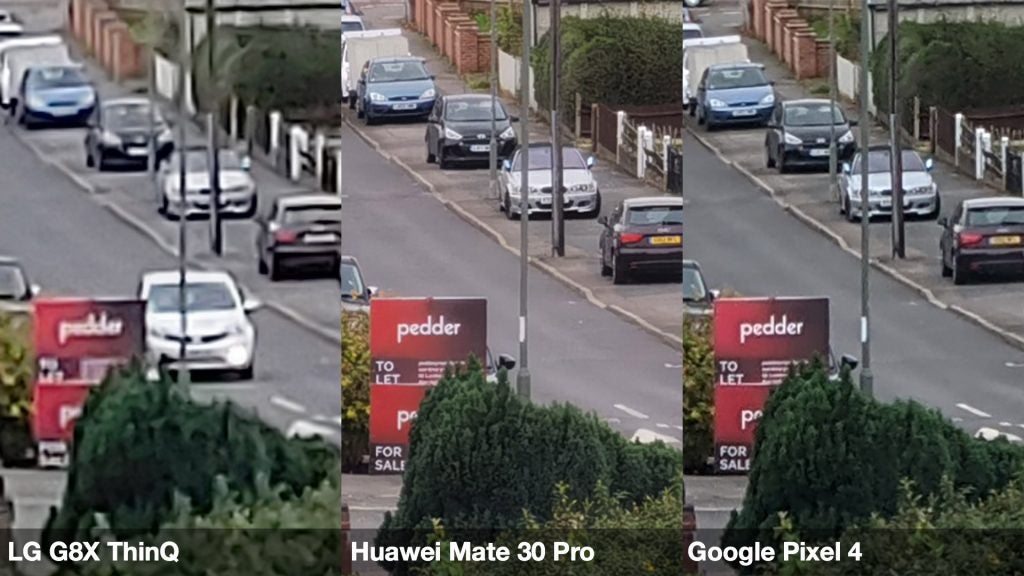
This is a deep crop of a 2/3x image taken of the same scene. There’s no mistaking the phones that have a zoom, and the one that doesn’t
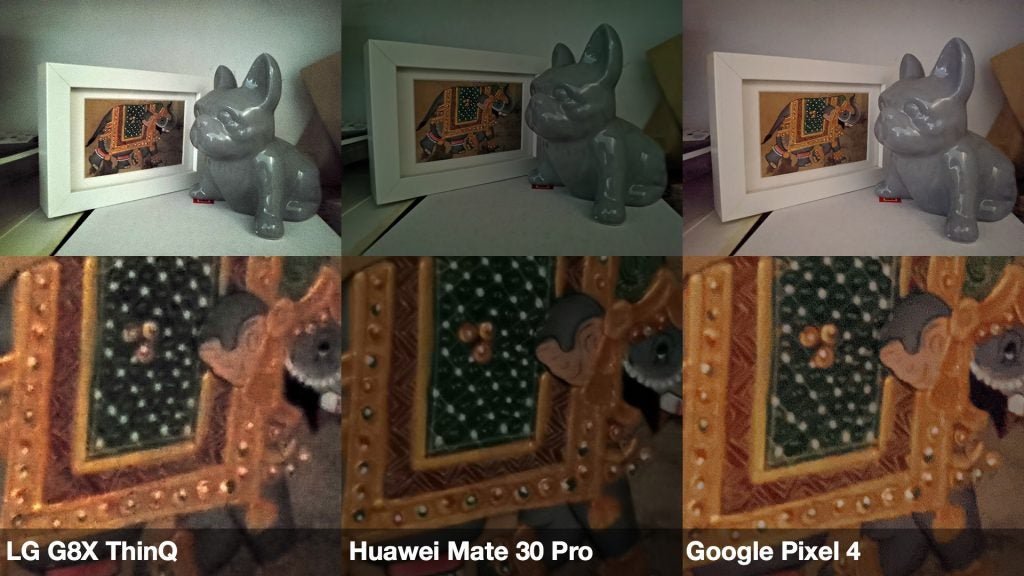
The LG night mode can make very low light images bright but the detail, noise and vignetting are better in the other phones
There are a lot of camera extras packed in here too. For example, you can use the dual screen as a way to review photos without leaving the shooting interface, or as a tilt screen so you can compose from awkward angles. It can also function as an off-centre flash for low-light selfies.
Not all the extras rely on the dual screen case either. There’s an ASMR mode for video that increases mic sensitivity — pretty niche — and an extra-stabilised video mode for shooting action. This uses the ultra-wide camera so there’s masses of spare image data for software stabilisation.
I recommend using the standard mode most of the time, though, as it lets you shoot at up to 4K, 60 frames (the ultra-stabilised mode is limited to 1080p) and already has pretty good stabilisation. Image quality is better too, as the main camera sensor is superior.
The ultra-wide camera is fun to play around with too, but its not one of the best around. Some darker tones take on a purplish hue, and this secondary camera has a fixed focus so is no use for close-ups.
Here are some more sample images:




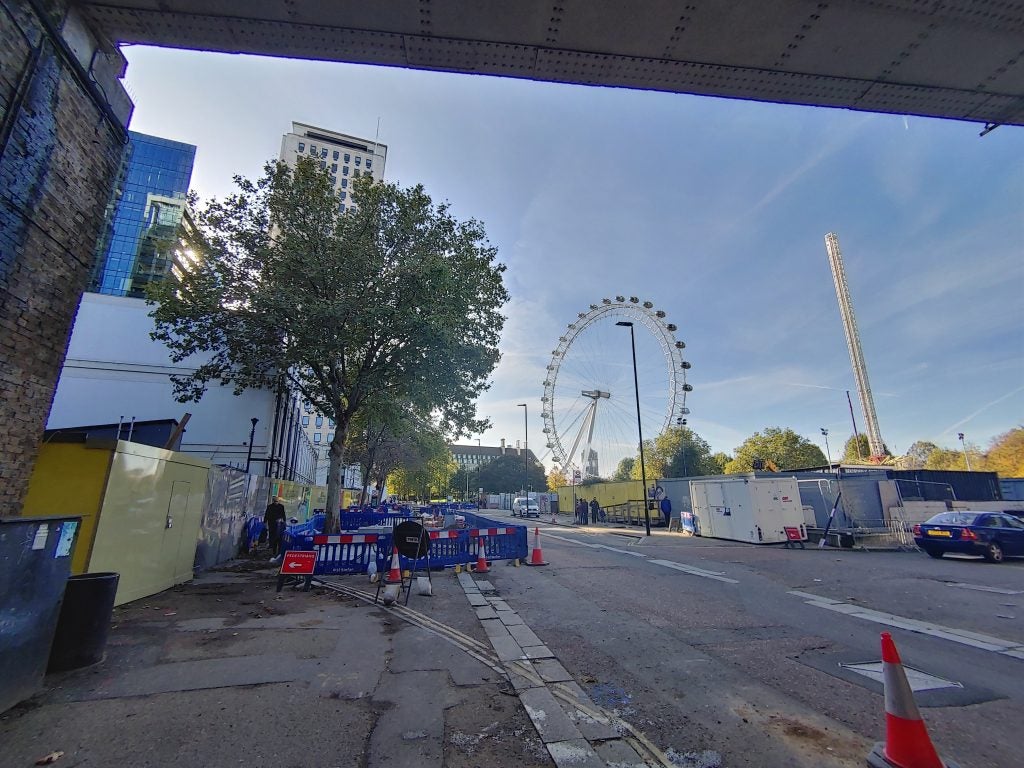
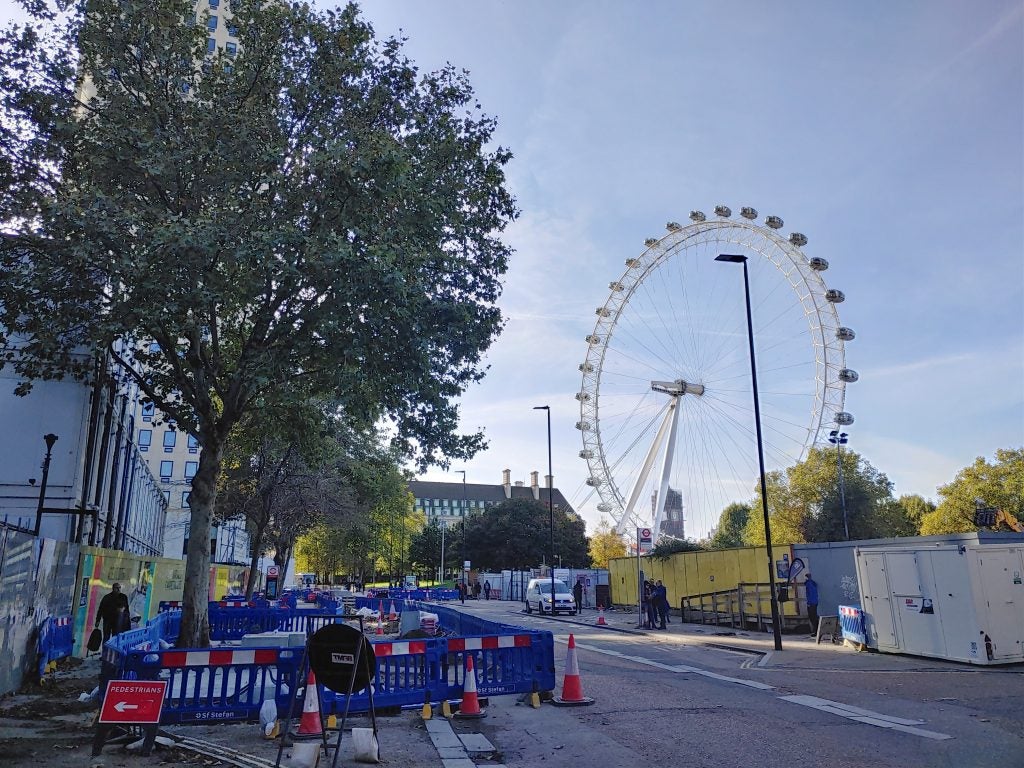
I’m a little disappointed by the front camera too. It uses a 32-megapixel sensor, but tends to leave fine facial hair detail looking soft even in good lighting.
The purpose of all those megapixels is actually for pixel binning, where sensor pixels are clustered to increase sensitivity in lower light. This does work pretty well. The LG G8X ThinQ’s front camera actually holds up better in worse conditions, relative to its major competitors.
LG G8X ThinQ Battery life – Good, but not the best
The LG G8X ThinQ has a 4000mAh battery, which has become the expected size for a large-screen phone. This phone’s longevity is split. Use it without the dual screen add-on and it’s great. One lighter-use weekend day I ended up with 50% charge left.
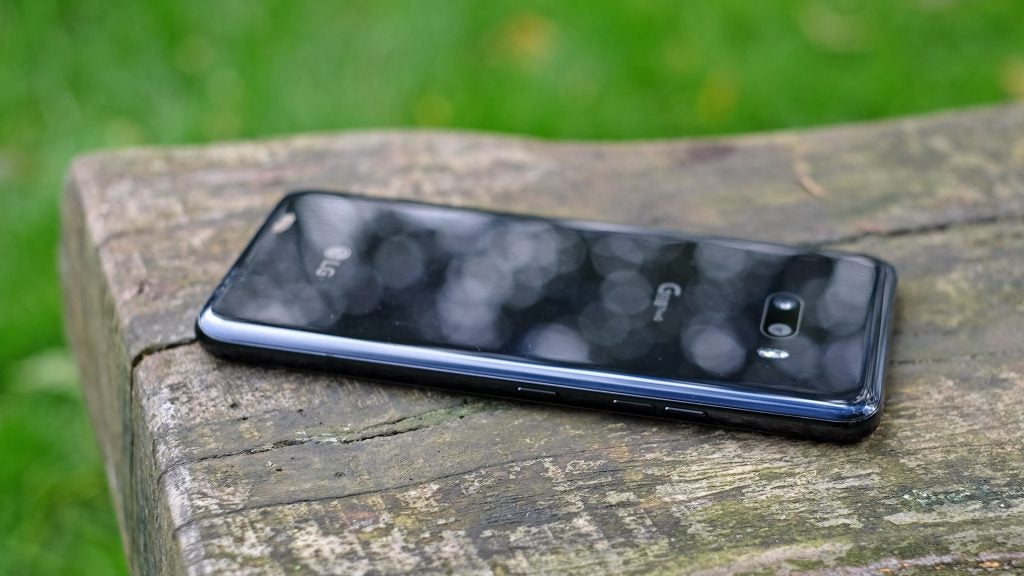
On more hectic weekdays, I tend to have around 20-30% left. I use my phone fairly intensively during the week, so this is a good result.
However, the dual screen drains the battery quite significantly as it does not have a power source of its own and a second 6.4-inch OLED is not a tiny power draw. For this reason you’ll likely only want to switch the second screen on when needed. The LG G8X ThinQ comes with a fast charger.
Should you buy the LG G8X ThinQ?
Curiosity is one of the best reasons to buy the LG G8X ThinQ. It’s a solid all-round phone for those who want a high-end mobile that costs less than the biggest names, but the Xiaomi Mi 9T Pro and OnePlus 7T simply cost less.
The dual screen accessory is the truly unusual part, and it’s a mixed bag. It’s fiddly and a bit buggy, the side-by-side multi-tasking isn’t arguably all that useful. But the virtual gamepad feature is interesting, particularly as LG has gone well beyond the basics. It lets you create your own virtual gamepads, adding only the buttons you need.
I leave the dual screen add-on at home more often than not, but there’s real value here if you use mobile games to make your journey to work less of a chore.
Verdict
A quirky Android phone that should interest mobile gaming fans.
How we test phones
We test every mobile phone we review thoroughly. We use industry standard tests to compare features properly and we use the phone as our main device over the review period. We’ll always tell you what we find and we never, ever, accept money to review a product.


